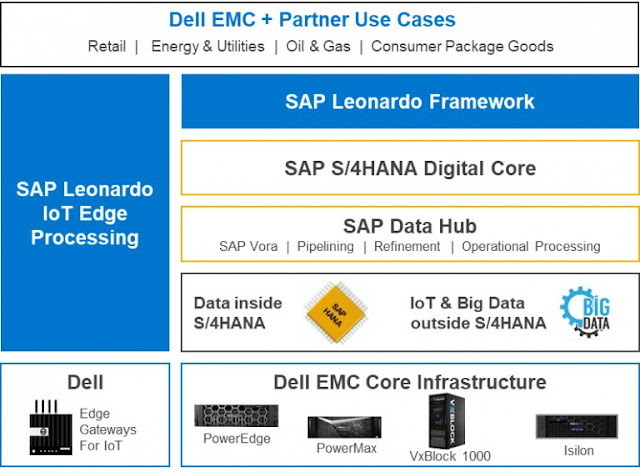Dell Technologies World 2019 is finally here and I couldn’t be more excited. This event means a lot to me personally. Not only does it provide an opportunity to listen closely to the needs of our customers and partners, it’s our chance to share the latest product updates we’ve designed to address your most pressing technology and business challenges.
One common theme of my conversations over the last year or so, is that we are all living in a world where digital transformation is defining winners and losers, and data has quickly become the most valuable asset for many organizations. Data is fueling new products and services, next-gen business applications, and powerful game-changing technologies such as artificial intelligence and IoT. As this data capital landscape becomes increasingly complex, more attention must be paid to where your data resides, how it is managed and how it is protected. I’m very excited to share the latest Dell EMC storage innovations, designed to unlock and maximize the value of your data capital.
One common theme of my conversations over the last year or so, is that we are all living in a world where digital transformation is defining winners and losers, and data has quickly become the most valuable asset for many organizations. Data is fueling new products and services, next-gen business applications, and powerful game-changing technologies such as artificial intelligence and IoT. As this data capital landscape becomes increasingly complex, more attention must be paid to where your data resides, how it is managed and how it is protected. I’m very excited to share the latest Dell EMC storage innovations, designed to unlock and maximize the value of your data capital.
Introducing Dell EMC Unity XT – No Compromise Midrange Storage
Dell EMC Unity originally launched almost three years ago and thousands of customers have embraced this midrange solution for its simplicity, performance, and affordability – in fact, we have now sold over 40,000 systems. This unique system consolidates your data capital across block, file and VMware workloads onto a single solution and has a well-deserved reputation for operational simplicity. CloudIQ adds additional storage monitoring and analytics – putting infrastructure insight in the palm of your hand.
We’re thrilled to announce Dell EMC Unity XT Series, the next-generation of Dell EMC Unity. We’ve taken this best-in-class solution to a new level including drastically improved performance, greater efficiency, and new capabilities and services designed for a multi-cloud world. With Dell EMC Unity XT, we set out to deliver a storage array without compromise at midrange price points. Some midrange platforms, especially those that are active-passive architectures, struggle with processing data, running data reduction, and data services like replication at the same time without impacting application performance. Others force you to make tradeoffs – like sub-par file capabilities, which limit the value it can provide your business. Dell EMC Unity XT has eliminated these tradeoffs.
Designed for Performance
Compared with the previous generation, Dell EMC Unity XT delivers up to 2x the performance with 75% better response times and supports up to 52% more virtual desktops without any performance impact. Furthermore, it is up to 67% faster than its closest competitor. Dell EMC Unity is NVMe ready, which will accelerate performance even further. These performance improvements mean faster operations, enabling you to improve the level of service you provide to your customers.
Optimized for Efficiency
Dell EMC Unity XT improved its data reduction capabilities, now enabling you to realize up to 5:1 data reduction rate. While that data reduction rate is impressive, the overall system efficiency is just as important, and Dell EMC Unity XT can utilize 85% of its system capacity (from raw to usable capacity). Combining written data reduction guarantees and system utilization rates, Dell EMC Unity XT is now 29% more efficient than the competition Speaking of guarantees, we are excited to now offer a 3:1 data reduction guarantee with no assessment for Dell EMC Unity XT as part of the Future Proof Loyalty Program.
Built for Multi-Cloud
Your data center is most likely evolving towards a model leveraging not just one, but multiple public clouds in conjunction with your on-premises infrastructure. At Dell Technologies, we are focused on providing solutions for your multi-cloud journey – including both the Dell Technologies Cloud and Dell Technologies Cloud enabled infrastructure. Dell EMC Unity XT is a core part of that strategy, as it can be a building block for the Dell Technologies Cloud, as part of a validated design. In addition, you can run Dell EMC Unity XT in a public cloud, seamlessly move data to the cloud and is available as a service via the new Dell EMC Cloud Storage Services.
Dell EMC Unity XT will start shipping later this quarter and will be available in both All-Flash and Hybrid configurations.
PowerMax Innovation from Intel Optane to Containers
Since its introduction last year, Dell EMC PowerMax has delivered breakthrough innovation for data storage. Recently named 2018 enterprise storage product of the year and technology innovator by CRN, PowerMax solves demanding online transactional applications where low latency is critical, and the highest resiliency is paramount. PowerMax is defined by a powerful architecture, simple operation and trusted innovation. Market leaders tend to partner with other market leaders, and Dell EMC and Intel are great examples of this. We have a partnership focused on innovation that spans decades. To that end, we have been working closely with Intel as the lead development partner for the new Dual Port Intel® Optane™ Technology drive – the next generation of media designed for the most demanding enterprise storage environments. Dell EMC PowerMax will be the first true scale-out storage array to ship with Intel Optane DC drives used for persistent storage by year end. With these Storage Class Memory (SCM) drives, PowerMax system latencies will be reduced by up to 50% – pretty impressive for a system that already provides sub 300 microsecond response times. PowerMax’s real-time machine learning engine automated data placement maximizes SCM investment. The modern architecture of PowerMax, with end-to-end NVMe, combined with SCM, maximizes the performance of your mission critical applications and harnesses the untapped value of your data capital.
I’m also excited to announce some ‘outside the box’ innovation with expanded automation and container support. We’ve taken automation even further for VMware customers and now offer integration with a VMware vRealize Orchestrator plug-in. This complete set of workflows, actions and APIs available as a PowerMax plug-in, automates operations and improves agility for VMware users. For non-VMware users, this summer, we are releasing a comprehensive set of Ansible Playbooks which can be used to build, configure and manage heterogeneous environments for the upcoming wave of new IT requirements.
As containers are increasingly leveraged for production applications, persistent storage has become a requirement. To support this, the industry recently finalized a standard API for container orchestration to talk to storage plug-ins – called the Container Storage Interface (CSI). I’m excited to announce that the CSI plug-in for PowerMax is coming this summer. PowerMax – the only platform in the industry that can support everything from Mainframe to Containers – all in one system.
Isilon – Manage the Data Deluge, Not Your Storage System
Industries such as automotive, life sciences, media and entertainment have been experiencing explosive data growth for years. This growth is now expanding across multiple organizations because of the need to drive next-generation workloads such as data analytics and artificial intelligence, as well as cloud native applications. Organizations need to run these workloads on-premises and in the cloud. This data deluge in unstructured data is what Dell EMC Isilon is designed for and why it’s become the industry leading scale-out NAS platform.
I’m excited to announce the latest Isilon software and hardware, designed to ensure you can spend more time unlocking your data capital and less time managing your storage environment.
Designed for Simplicity at Scale
As you’re inundated with more data, you usually can’t add resources to manage the growing environment. Isilon changes this narrative by providing scale out without the headcount. Our latest software release, OneFS 8.2, enables scale up to 252 nodes which means you can manage up to 58 PB, as if it were terabytes, and with a 945 GB/s aggregate throughput per cluster, your workloads can excel.
Architected for Workload Agility
Not only are our customers struggling with data management and growth, they are struggling with data center space and have been looking for an Isilon node with the performance of a hybrid and capacity of an archive node. Which is why I’m excited to announce the Isilon H5600 with 40% better rack density, almost double single stream throughput, 31% better write throughput, double the memory and SSD caching, all in a 4U chassis. This has a massive impact on markets like media and entertainment, since Isilon H5600 will be able to support one 4k uncompressed edit stream per node.
Optimized for Multi-cloud
We love giving our customers flexibility – especially as it comes to extending your data center to the cloud. I am thrilled to announce a few cloud enhancements for Isilon. Our new Dell EMC Cloud Storage Services provides two paths to consume Isilon in a public cloud. We are officially announcing early access to Isilon file data services through Google Cloud Platform (GCP) this summer. This provides a seamless experience to leverage the industry leading scale out NAS system directly through GCP. In addition, Cloud Storage Services provides multi-cloud agility with a direct connection to multiple public clouds – ideal for disaster recovery, analytics and more. This service will allow customers to combine Isilon storage with the public cloud providers agile compute. Finally, we have enhanced Isilon CloudPools software to provide policy-based automated tiering that lets you seamlessly move data from on prem to public cloud – ideal for archiving. We have now expanded support to Alibaba Cloud in addition to existing support for Amazon Web Services (AWS), GCP and Microsoft Azure.
As you can tell, my team has been busy innovating across our entire storage portfolio based on your feedback over the last year. We’re confident that this investment will enable you to unlock the value of your data capital and help you on your multi-cloud journey. With the significant investments we’ve made to modernize our product portfolio, maximizing the value of your data growth can be easier than ever.



























